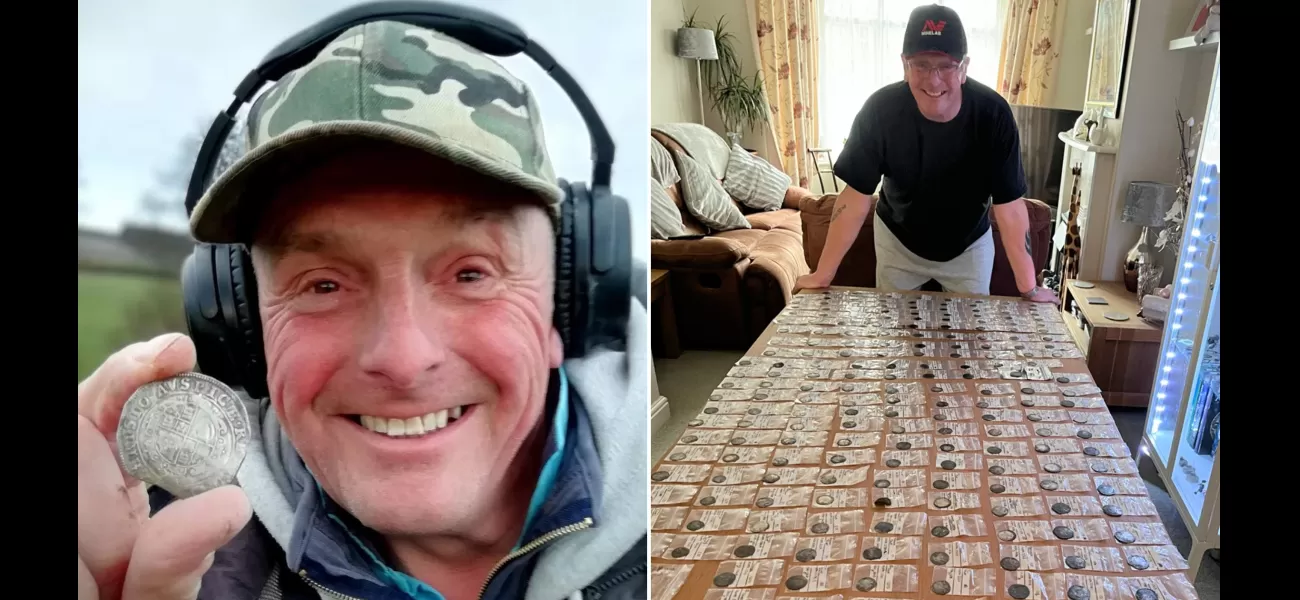Lucky man wins metal detector, finds coins worth £23,000.
The speaker was in disbelief.
April 7th 2024.

Mickey Richardson, a 63-year-old man, was lucky enough to win a metal detector in a raffle just three months before he stumbled upon a historic discovery. As a novice treasure hunter, he was thrilled to uncover a hoard of silver coins valued at £23,000 in a muddy field in the village of Ansty, located about nine miles northeast of Dorchester. It was one of Mickey's first finds, and he believes the coins were buried there in 1644 by a farmer during the English Civil War for safekeeping. However, it appears that the owner of the coins met an unfortunate fate before he was able to retrieve them, leaving them hidden until now.
Mickey was amazed to find 74 silver coins on the first day of his search, featuring a bust of King Charles I, and spent two days exhaustively digging up the remaining 160 coins. He shared, "I couldn't believe it. I was shattered after digging up those 74 coins, but I went back the next day hoping to round it up to 100. To my surprise, I found a total of 234 coins spread out over a wide area." The coins dated back to the reigns of King Edward VI in the 1550s, Queen Elizabeth I, James I, and Charles I. Some of the coins from the reigns of Elizabeth and James had been scratched, most likely by a former Catholic owner who disagreed with their Protestant beliefs and the reformation of the Catholic Church.
Mickey followed the law and turned the coins over to his local Finds Liaison Officer, who documents metal detector finds. The British Museum examined the coins before returning them to Mickey as the rightful owner. He was overjoyed when he learned that the coins were sold at London auctioneers Spink & Son for £23,000, including fees. He shared, "I was jumping up and down watching the auction live. It was an unforgettable experience." Mickey plans to split the proceeds 50/50 with the landowner and use his share to take a summer vacation with his wife, Rosalynd.
Mickey's interest in metal detecting began just a few months before his incredible find. He explained, "I had a very basic metal detector that I used to take to Bournemouth beach. But then I won a top-of-the-range metal detector in a Facebook group raffle for a metal detecting club. A few months later, I got permission to search the land in Ansty, which used to be a small mudhouse village and was once used to grow hops for brewing beer during the Napoleonic Wars." He had visited the area a couple of times and only found a copper coin until the day he discovered the hoard.
Mickey recalled, "I was about to call it a day when I got a strong signal and dug up a Charles I shilling. Then I swept the area again and found another signal, and then another, and another. It was a day I will never forget." He was expecting the coins to sell for £10,000 at auction but was pleasantly surprised when they sold for £23,000. However, for Mickey, it was never about the money; it was about preserving the history and the coins themselves. The money was just an added bonus.
The coin specialist at Spink & Son, Ella Mackenzie, shared, "This ensemble represents a crucially formative period in England's history. These coins were in circulation during a time of great change, politically, socially, and religiously." She added, "It was a rare privilege to handle this hoard." While Britain has a rich history of Civil War hoards, with almost 400 cases documented, it is still rare for them to come up for public sale. In fact, just last month, a treasure hunter discovered the largest golden nugget ever found in England, worth £30,000. Richard Brock, 67, found the 64.8g 'Hiro's Nugget' while on an expedition in Shropshire Hills with a faulty metal detector.
Mickey was amazed to find 74 silver coins on the first day of his search, featuring a bust of King Charles I, and spent two days exhaustively digging up the remaining 160 coins. He shared, "I couldn't believe it. I was shattered after digging up those 74 coins, but I went back the next day hoping to round it up to 100. To my surprise, I found a total of 234 coins spread out over a wide area." The coins dated back to the reigns of King Edward VI in the 1550s, Queen Elizabeth I, James I, and Charles I. Some of the coins from the reigns of Elizabeth and James had been scratched, most likely by a former Catholic owner who disagreed with their Protestant beliefs and the reformation of the Catholic Church.
Mickey followed the law and turned the coins over to his local Finds Liaison Officer, who documents metal detector finds. The British Museum examined the coins before returning them to Mickey as the rightful owner. He was overjoyed when he learned that the coins were sold at London auctioneers Spink & Son for £23,000, including fees. He shared, "I was jumping up and down watching the auction live. It was an unforgettable experience." Mickey plans to split the proceeds 50/50 with the landowner and use his share to take a summer vacation with his wife, Rosalynd.
Mickey's interest in metal detecting began just a few months before his incredible find. He explained, "I had a very basic metal detector that I used to take to Bournemouth beach. But then I won a top-of-the-range metal detector in a Facebook group raffle for a metal detecting club. A few months later, I got permission to search the land in Ansty, which used to be a small mudhouse village and was once used to grow hops for brewing beer during the Napoleonic Wars." He had visited the area a couple of times and only found a copper coin until the day he discovered the hoard.
Mickey recalled, "I was about to call it a day when I got a strong signal and dug up a Charles I shilling. Then I swept the area again and found another signal, and then another, and another. It was a day I will never forget." He was expecting the coins to sell for £10,000 at auction but was pleasantly surprised when they sold for £23,000. However, for Mickey, it was never about the money; it was about preserving the history and the coins themselves. The money was just an added bonus.
The coin specialist at Spink & Son, Ella Mackenzie, shared, "This ensemble represents a crucially formative period in England's history. These coins were in circulation during a time of great change, politically, socially, and religiously." She added, "It was a rare privilege to handle this hoard." While Britain has a rich history of Civil War hoards, with almost 400 cases documented, it is still rare for them to come up for public sale. In fact, just last month, a treasure hunter discovered the largest golden nugget ever found in England, worth £30,000. Richard Brock, 67, found the 64.8g 'Hiro's Nugget' while on an expedition in Shropshire Hills with a faulty metal detector.
[This article has been trending online recently and has been generated with AI. Your feed is customized.]
[Generative AI is experimental.]
0
0
Submit Comment





